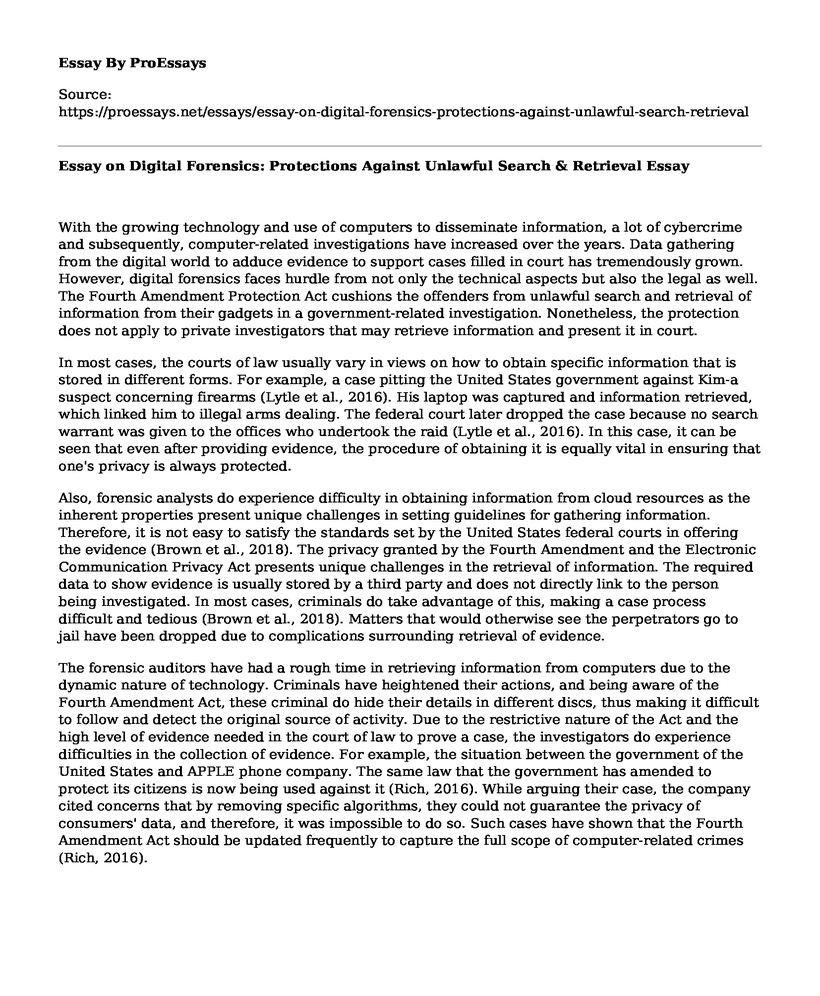With the growing technology and use of computers to disseminate information, a lot of cybercrime and subsequently, computer-related investigations have increased over the years. Data gathering from the digital world to adduce evidence to support cases filled in court has tremendously grown. However, digital forensics faces hurdle from not only the technical aspects but also the legal as well. The Fourth Amendment Protection Act cushions the offenders from unlawful search and retrieval of information from their gadgets in a government-related investigation. Nonetheless, the protection does not apply to private investigators that may retrieve information and present it in court.
In most cases, the courts of law usually vary in views on how to obtain specific information that is stored in different forms. For example, a case pitting the United States government against Kim-a suspect concerning firearms (Lytle et al., 2016). His laptop was captured and information retrieved, which linked him to illegal arms dealing. The federal court later dropped the case because no search warrant was given to the offices who undertook the raid (Lytle et al., 2016). In this case, it can be seen that even after providing evidence, the procedure of obtaining it is equally vital in ensuring that one's privacy is always protected.
Also, forensic analysts do experience difficulty in obtaining information from cloud resources as the inherent properties present unique challenges in setting guidelines for gathering information. Therefore, it is not easy to satisfy the standards set by the United States federal courts in offering the evidence (Brown et al., 2018). The privacy granted by the Fourth Amendment and the Electronic Communication Privacy Act presents unique challenges in the retrieval of information. The required data to show evidence is usually stored by a third party and does not directly link to the person being investigated. In most cases, criminals do take advantage of this, making a case process difficult and tedious (Brown et al., 2018). Matters that would otherwise see the perpetrators go to jail have been dropped due to complications surrounding retrieval of evidence.
The forensic auditors have had a rough time in retrieving information from computers due to the dynamic nature of technology. Criminals have heightened their actions, and being aware of the Fourth Amendment Act, these criminal do hide their details in different discs, thus making it difficult to follow and detect the original source of activity. Due to the restrictive nature of the Act and the high level of evidence needed in the court of law to prove a case, the investigators do experience difficulties in the collection of evidence. For example, the situation between the government of the United States and APPLE phone company. The same law that the government has amended to protect its citizens is now being used against it (Rich, 2016). While arguing their case, the company cited concerns that by removing specific algorithms, they could not guarantee the privacy of consumers' data, and therefore, it was impossible to do so. Such cases have shown that the Fourth Amendment Act should be updated frequently to capture the full scope of computer-related crimes (Rich, 2016).
Conclusion
Individuals involved in crimes can hide under the amendment and execute activities against the same people that the government seeks to protect. The clause should also capture the work being done by private offices since the citizens' rights can be breached. Also, the government can circumvent the law by investing heavily in private investigators in a case of high interest. Through this, the information is retrieved, and evidence presented without any breach of the amendment. The private offices can also be compromised; therefore, the law should gauge how they operate to make sure that the information provided is correct. The right to privacy is a noble thing. With the growing crimes, he Fourth Amendment should capture a broader range of issues to avert any grey area during court ruling and make sure that the government, the public, and the accused are equally protected.
References
Lytle, A., Stephens, N., Conner, J., Bashiri, S., & Jones, S. (2016). Digital Forensics and Enforcement of the Law. https://internetinitiative.ieee.org/home/sitemap/20-newsletter/396-digital-forensics-and-enforcement-of-the-law
Brown, A. J., Glisson, W. B., Andel, T. R., & Choo, K. K. R. (2018). Cloud forecasting: Legal visibility issues in saturated environments. Computer Law & Security Review, 34(6), 1278-1290. https://www.sciencedirect.com/science/article/abs/pii/S0267364917302522
Rich, M. L. (2016). Machine learning, automated suspicion algorithms, and the fourth amendment. University of Pennsylvania Law Review, 871-929. https://www.jstor.org/stable/24753528?seq=1
Cite this page
Essay on Digital Forensics: Protections Against Unlawful Search & Retrieval. (2023, Aug 16). Retrieved from https://proessays.net/essays/essay-on-digital-forensics-protections-against-unlawful-search-retrieval
If you are the original author of this essay and no longer wish to have it published on the ProEssays website, please click below to request its removal:
- Essay Sample on Informants and Witnesses
- Legislation Testimony of Affordable Care Act Essay Example
- Fourth Dimension: Digital Communication Technology Essay
- Essay Example on Humans: Nature of Justice & Injustice Examined
- Essay Sample on Pre-Charge Diversion Programs in New Brunswick: A Community-Level Model for Justice
- Essay Example on Data Literacy: Propelling Workforce to Success
- Essay Example on Martin Luther King's I Have a Dream: A Symbol of Hope and Freedom







